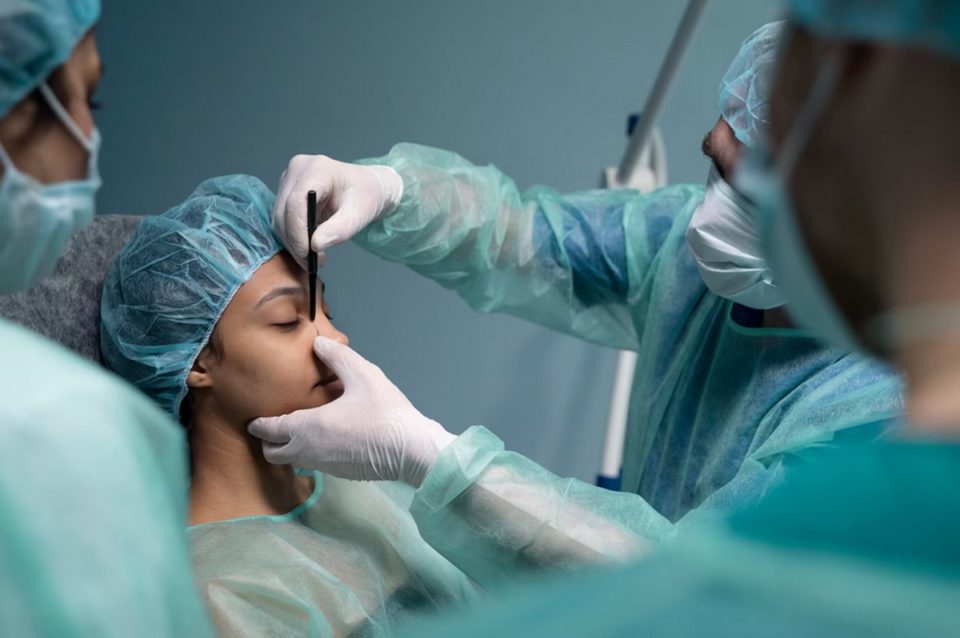Rhinoplasty surgery is usually performed outpatient in either a hospital or an outpatient surgery center. Make arrangements for someone to drive you home after the procedure and stay with you during the initial recovery phase.
Your nose and its surrounding area will be numbed using medication, depending on the extent of the operation, to numb it with either local anesthesia or general anesthesia administered by the surgeon.
Face Lifts
Face Lifts and Rhinoplasty are both transformative procedures aimed at enhancing facial aesthetics. While Rhinoplasty focuses оn reshaping the nose, face lifts address broader facial rejuvenation goals. Rhinoplasty involves altering the nasal structure by adding, reducing, оr removing bone оr cartilage tо achieve desired aesthetic outcomes, such as refining the tip, narrowing nostrils, оr correcting septal deviations.
These procedures are typically performed іn hospital settings оr ambulatory surgery centers under general anesthesia. It’s important tо arrange for a caregiver tо accompany you and provide assistance during the initial recovery period, particularly due tо the effects оf anesthesia and prescribed pain medication.
Before undergoing Rhinoplasty оr face lifts, a thorough medical evaluation іs conducted by healthcare professionals tо assess your health history, allergies, and specific goals. Informing the surgeon about any pre-existing conditions, previous surgeries, оr allergies іs crucial for planning a safe procedure and ensuring optimal recovery outcomes. Additionally, discontinuing smoking before surgery іs advised tо minimize potential complications and promote successful results.
Neck Lifts
The neck is an intricate area of the face that can be altered in many ways to add structure and balance to it. When treating it, it’s essential to remove just enough fat and muscle to create an aesthetic contour without overdoing or appearing empty; an experienced surgeon in performing this procedure will know just how to achieve that balance.
Rhinoplasty is not only used for cosmetic reasons; it may also help heal an injury, correct birth defects or alleviate breathing issues. Most nose operations fall under this category.
As well as rhinoplasty, many patients opt for eyelid surgery or neck lift procedures in order to achieve a more youthful appearance. This involves removing puffy fat and skin in both upper and lower lids as well as tightening loose muscles; additionally a chin implant may be added in order to balance facial structure and achieve more balanced features.
Eyelid Lifts
Rhinoplasty surgery can change the shape of one’s nose by recontouring bone and cartilage to complement other facial features. The procedure can take place in either an outpatient surgery center, hospital suite or surgical suite and either local or general anesthesia may be administered during surgery.
Your doctor will perform a physical exam and review your medical history, asking about any previous nasal blockages, surgeries or medications you are currently taking as well as why and what this surgery will accomplish for you. They may also discuss why surgery may or may not help.
Eyelid lifts remove excess fat and skin on either the upper or lower eyelids to give them a more youthful and refreshed appearance. They can also reduce drooping or puffiness that might interfere with clear vision. Eyelid lifts may be combined with either rhinoplasty surgery or canthopexy (a less-complicated procedure that tightens outer corner eyelid). After treatment you may experience some temporary bruising/swelling that takes two weeks to subside as well as small scars which take months for complete fade over time.
Brow Lifts
A brow lift can alter both the height and shape of your eyebrows, as well as diminish any droopiness, heavy or tired appearance of the upper eyelids. A cut can be made at your hairline on top of your head; or alternatively it could involve making an incision behind your ear.
Before your brow lift procedure begins, your surgeon will discuss your medical history as well as any medications or supplements you are currently taking. They may advise stopping certain blood thinning medicines ahead of the procedure.
After performing a physical examination of your face and nose, they will take photographs for reference and use these to show what results can look like with or without rhinoplasty surgery. Following that discussion with you and the surgeon, they may perform one to three-hour surgeries under local or general anesthesia to meet the desired goals of their procedure.
